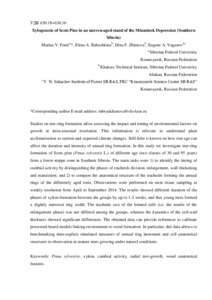Xylogenesis of Scots Pine in an uneven-aged stand of the Minusinsk Depression (Southern Siberia)
Скачать файл:
Автор:
Marina V. Fonti
Elena A. Babushkina
Dina F. Zhirnova
Eugene A. Vaganov
Коллективный автор:
Научно-исследовательская часть
Дата:
2020-06Журнал:
Journal of Siberian Federal UniversityБиблиографическое описание:
Marina V. Fonti. Xylogenesis of Scots Pine in an uneven-aged stand of the Minusinsk Depression (Southern Siberia) [Текст] / Marina V. Fonti, Elena A. Babushkina, Dina F. Zhirnova, Eugene A. Vaganov // Journal of Siberian Federal University: Biology. — 2020. — Т. 13 (№ 2). — С. 197-207Аннотация:
Studies on tree-ring formation allow assessing the impact and timing of environmental factors on growth at intra-seasonal resolution. This information is relevant to understand plant acclimatization to current and expected climate changes. Still little is known on how tree age can affect the duration and intensity of annual ring formation. In this study we investigate tree-ring formation of Scots pine (Pinus sylvestris L.) of different age (two classes of 30 and 95 years) from a forest-steppe zone in Southern Siberia. The main tasks were 1) to identify the timing of cambial activity by distinguishing the phases of tracheids division, enlargement, wall thickening and maturation; and 2) to compare the anatomical structure of the tracheids forming the annual rings of the differently aged trees. Observations were performed on stem tissue sampling at weekly resolution from April to September 2014. The results showed different duration of the phases of xylem formation between the groups by up to 1-2 weeks, and that young trees formed a slightly narrower ring width. The tracheids size of the formed cells (i.e. the results of the enlargement phase) was not differed among the groups, whereas the dynamics of the cell-wall thickness showed significant differences. The obtained data can provide references to calibrate processed-based models linking environment to wood formation. In particular, this data allows to benchmarking time-explicit simulated measures of annual ring increment and cell anatomical structures to observation in mature trees growing under natural conditions.

